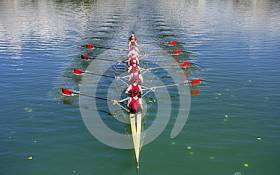Displaying items by tag: Senior Eights
UCD Best Senior Eight at Trinity Regatta
#Rowing: UCD took away the biggest prize at Trinity Regatta today. They had a clear win over Commercial in the semi-final, by one and a quarter lengths, and beat the hosts’ eight in the final by three and a half lengths. Trinity’s women’s senior eight won their final, beating Dutch visitors KSRV Nord, who had come through the semi-final after UCD were disqualified.
Trinity Regatta, Islandbridge, Saturday (Selected Results)
Men
Eight – Senior: UCD bt Trinity 3½ l. Intermediate: UCD bt Commercial ¾ l. Club: UCD bt Commercial. Novice: Trinity A bt Trinity C 2l. Jun 18: Commercial bt Neptune 2l. Jun 16: Portora bt Commercial.
Four – Senior, coxed: UCD bt Trinity A. Intermediate, coxed: UCD bt Trinity B.
Pair – Senior: UCD bt Trinity A.
Sculling, Quadruple – Novice, coxed: Neptune bt King’s Hospital. Jun 18: Commercial bt Carlow 2½ l. Jun 18, coxed: Three Castles bt Commercial A. Jun 16, coxed: Commercial bt Portora 4l. Jun 15, coxed: Portora bt Blackrock A.
Double – Sen: Sligo bt Carlow 2l. Jun 15: Three Castles bt Bann A.
Single – Senior: Garda (D Kelly) bt Trinity (Van Gent). Inter: Garda (Allen) bt Carlow (Murphy). Club: Carlow (Nolan) bt Sligo (Patterson). Nov: Commercial (Jarvis) row over Queen’s (Foster). Jun 18: Graiguenamanagh (Lennon) bt (O’Brien). Jun 16: Carlow bt Carlow (Mead). Jun 15: Three Castles (Flynn) bt Three Castles (Keogh).
Women
Eight – Senior: Trinity bt KSRV Nord (Holland) easily. Inter: Commercial bt Trinity 5½ l. Club: UCD bt Commercial 2¼ l. Nov: UCD bt Trinity B 3l. Jun 16: Portora bt Carlow 4l. Jun 15: Carlow bt Portora A.
Four – Club, coxed: Trinity A bt Commercial B.
Sculling, Quadruple – Novice, coxed: Commercial B bt Neptune A . Jun 18: Carlow bt Commercial. Jun 18, coxed: Carlow bt Commercial 2½ l. Jun 16, coxed: Bann bt Commercial. Jun 15, coxed: Commercial bt Graiguenamanagh easily.
Double – Jun 15: Commercial bt Galway easily.
Single, Sen: Trinity (G Foley) bt Commercial (J Besse) 4l. Club One: Carlow (A Byrne) bt Commercial (O’Connor) 2l. Jun 18: Neptune (Feerick) bt Bann (Wylie). Jun 16: King’s Hospital (Wedgewood) bt Commercial (K Dolan)
UCD Win Big Pot at National Rowing Championships
UCD are the new Irish men’s senior eights champions. In extremely difficult conditions at the National Rowing Championships in Cork, the big crew saw off an early challenge by Queen’s University and a late charge by NUIG/Grainne Mhaol to win their first Big Pot in 38 years.
The UCD women’s senior eight completed a great day for the college when they beat Muckross in their final.
National Rowing Championships, National Rowing Centre, Cork - Day Three
Men
Eight – Senior: 1 UCD (S Craven, P Grogan, D Pierce, D Neale, F Manning, S Jacob, G Duane, T Doyle; cox: J Lynch) 5:39.5, 2 NUIG/Grainne Mhaol 5:41.8, 3 Queen’s University 5:44.2, 4 Trinity 6:08.7.
Four – Novice, coxed: 1 NUIG, 2 Cappoquin, 3 UCC.
Pair – Intermediate: 1 Queen’s University (A Little, K Duffy) 6:58.4, 2 NUIG 8:03.9, 3 Carlow 7:01.1. Junior 18A: 1 Bann 6:53.2, 2 St Joseph’s College 6:57.1, 3 Presentation College 7:06.9.
Sculling, Quadruple – Junior 18A: 1 Castleconnell 6:06.2, 2 Skibbereen 6:12.0, 3 Offaly 6:12.8. Junior 16, coxed (non-Championship): 1 Galway 6:45.4, 2 Tribesmen 6:48.0, 3 Cork 6:51.8
Double – Intermediate: 1 Carlow 6:40.5, 2 Skibbereen 6:41.0, 3 Queen’s 6:55.0.
Single – Senior: 1 Muckross (S Casey) 6:56.0, 2 Skibbereen A (P O’Donovan) 6:56.5, 3 Muckross (C Moynihan) 7:20.8, 4 Skibbereen (Murphy) 7:28.3, 5 Skibbereen (McCarthy) 7:37.0. Lee Valley (Keohane) did not start.
Women
Eight – Senior: 1 UCD (C Tanner, K Joy, C Ni Reachtagain, N Fearon, S Bennett, L Gannon, L Reid, A Gilligan; cox: E Craven) 6:29.9, 2 Muckross 6:34.1, 3 St Michael’s 6:38.6, 4 NUIG 6:40.5, 5 Queen’s 6:42.2, 6 Trinity 7:07.8.
Intermediate: 1 Queen’s University 6:33.8, 2 Trinity 6:41.1, 3 St Michael’s 6:44.2. Novice: 1 Galway 6:42.6, 2 Queen’s 6:50.2, 3 Carrick-on-Shannon 7:01.5. Junior 16 (non-Championship): 1 Galway 6:49.2, 2 Cork 6:59.6, 3 Portora 7:09.0.
Pair – Junior 18: 1 St Michael’s 7:43.9, 2 Portora 7:52.4, 3 Commercial 8:41.3.
Sculling, Quadruple – Novice: 1 Commercial 7:56.3, 2 Neptune 8:06.0, 3 Clonmel 8:11.9. Junior 18A: 1 Skibbereen 6:58.7, 2 Cork 7:05.5, 3 Neptune 7:13.5.
Single – Senior: 1 City of Derry (L D’Urso) 7:56.5, 2 Three Castles (E Moran) 8:10.9, 3 Portora (H Nixon) 8:20.4, 4 Three Castles (Quinn) 8:28.6, 5 Old Collegians (Walshe) 9:08.7. Killorglin (M Dukarska) did not finish. Intermediate: 1 City of Derry (L D’Urso), 2 Skibbereen (Walsh), 3 Shandon (Corcoran-O’Hare).
























